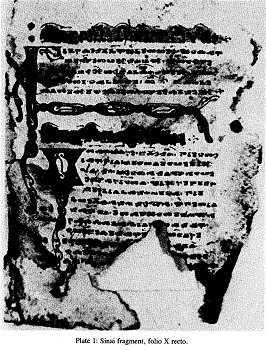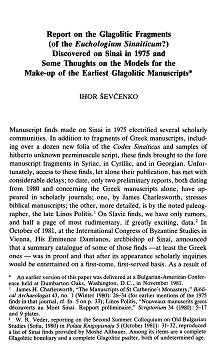Part I. (Prayers 1-4)
120
Part II. (Prayers 5 and 6)
136
Part III. (The new fragments possibly belonging
to the Glagolitic Euchologium Sinaiticum)
138
Part IV. (New information: the word bystrъ
meaning “wily” or “cunning”) 140
Part V. (Italo-Greek parallels to the new
fragments. Further possible connections: Rome, Carolingian, insular)
141-147
Plates and figures (pp. 123-131):
Plate 1: Sinai fragment, folio X recto
Plate 2: Sinai fragment, last folio verso
Fig. 1: Sinai fragment, last folio verso and folio (X plus A)
verso, detail. – Fig. 2: Euchologium Sinaiticum, 100 b
Fig. 3: Euchologium Sinaiticum, 61 b. – Fig. 4:
Euchologium Sinaiticum, 95 b
Fig. 5: Cryptoferratensis B. a. IV, fol. 145r
(a. 991). – Fig. 6: Vaticanus Reginensis Gr. 75, fol. 49r
(ca. a. 983)
Fig. 7: Oxoniensis Bodl. Laud Gr. 75, fol. 326v.
(a. 976). – Fig. 8: Vaticanus Gr. 2138, fol. 35r (a. 991)
Fig. 9: Oxoniensis Bodl. Gr. 204, fol. 17r.
– Fig. 10: Vaticanus Gr. 2138, fol. 3v and 26r
(a. 991)
Fig. 11: Euchologium Sinaiticum, 77 b. – Fig. 12:
Euchologium Sinaiticum, 81 b
Fig. 13: Parisinus Lat. 12.048 (Sacramentary of
Gellone, end of the 8th century). – Fig. 14: Cryptoferratensis
A.α.Ill, fol. 1r
Fig. 15: Euchologium Sinaiticum, 14 b. – Fig. 16:
Atheniensis Bibl. Nat. 74, fol. 94r
Fig. 17: Psalterium Sinaiticum, fol. 121v.
– Fig. 18: Patmiacus Gr. 33, fol. 99r
Fig. 19: Euchologium Sinaiticum, 59 b. – Fig. 20:
Vaticanus Gr. 866, fol. 404v
Fig. 21: Euchologium Sinaiticum, 80 a. – Fig. 22:
Vaticanus Gr. 866, fol. 216r
Fig. 23: Euchologium Sinaiticum, 32 b. – Fig. 24:
Vaticanus Gr. 2138, fol. 29v (a. 991)
Fig. 25: Euchologium Sinaiticum, 23 a. – Fig. 26:
Codex Zographensis, fol. 131r
Fig. 27: Psalterium Sinaiticum, fol. 123r.
– Fig. 28: Codex Assemanianus, fol. 157v
Manuscript finds made on Sinai in 1975 electrified several
scholarly communities. In addition to fragments of Greek manuscripts,
including over a dozen new folia of the Codex Sinaiticus and samples
of hitherto unknown preminuscule script, these finds brought to the fore
manuscript fragments in Syriac, in Cyrillic, and in Georgian. Unfortunately,
access to these finds, let alone their publication, has met with
considerable delays; to date, only two preliminary reports, both dating from
1980 and concerning the Greek manuscripts alone, have appeared in scholarly
journals; one, by James Charlesworth, stresses biblical manuscripts; the
other, more detailed, is by the noted paleographer, the late Linos Politis.
[1] On Slavic finds, we have only rumors, and half a page of most
rudimentary, if greatly exciting, data. [2] In October of 1981, at the
International Congress of Byzantine Studies in Vienna, His Eminence Damianos,
archbishop of Sinai, announced that a summary catalogue of some of those
finds —at least the Greek ones — was in proof and that after its appearance
scholarly inquiries would be entertained on a first-come, first-served
basis.
*. An earlier version of this paper was
delivered at a Bulgarian-American Conference held at Dumbarton Oaks,
Washington, D.C., in November 1981.
1. James H. Charlesworth, “The Manuscripts of St Catherine’s
Monastery,” Biblical Archaeologist 43, no. 1 (Winter 1980): 26-34
(for earlier mentions of the 1975 finds in that journal, cf. fn. 5 on p.
33); Linos Politis, “Nouveaux manuscrits grecs decouverts au Mont Sinai.
Rapport préliminaire,” Scriptorium 34 (1980): 5-17 and 9 plates.
2. W. R. Veder, reporting on the Second Summer Colloquium on
Old Bulgarian Studies (Sofia, 1980) in Polata Knigopisnaja 5 (October
1981): 31-32, reproduced a list of Sinai finds provided by Moshé Altbauer.
Among its items are a complete Glagolitic homiliary and a complete
Glagolitic psalter, both of undetermined age.

120
As a result of all this, my report is the best that I can
proffer under the circumstances. [3]
I
In 1979 I was allowed to inspect — and to retake — four
photographs of non-Greek manuscript fragments that had come to the fore on
Sinai in 1975. Among them were two photos, apparently a recto and a verso of
a folio, of a text identified as Georgian by those who first worked on the
Sinai finds (plates 1 and 2, pp. 123-124). A glance at these photos suffices
for any Byzantinist, let alone Slavicist, to realize that what was labeled
as Georgian is, in fact, Glagolitic and that the new Glagolitic find belongs
to the earliest period of Slavic writing. A conservative guess is that the
date of the manuscript is no later than A.D. 1100.
At first, I, too, thought that we were dealing with a recto
and verso of one folio, but I soon realized that one of the photos showed
two folia. A detail illustration makes this point clear: fig. 1 (p. 125)
shows some lines of another folio, lines that are visible through the hole
in our verso and are disrupting the sequence in that verso’s relevant text.
Thus our fragments consist of two or more folia. From my present information
I deduce that they contain no less than three and no more than six folia.
[4] Thus, as far as I know, at most one-third of the newly-discovered
fragments is at present accessible outside of Sinai.
We shall speak briefly about the partly visible folio later;
first, however, let us turn to the contents of plates 1 and 2. I shall call
them “folio X recto” and “last folio verso,” respectively. Folio X recto
contains two prayers of the service of the Third and the Sixth Hours,
respectively. Last folio verso also contains two prayers, which belong to
the service of the lychnikon, or the beginning of the Vespers. They
are the prayers of the Sixth and of the Seventh Antiphon. These four prayers
were recited secretly by the priest during the antiphonic psalmody,
3. The Summary Catalogue of Greek manuscripts discovered in
1975 is by Dr. P. Nikolopoulos, Director of the National Library of Greece;
the analogous checklist of Slavic manuscripts is in a planning stage
(information of December 1981). I have been advised by the Sinai authorities
that until such a checklist is ready, they will not provide me with
photographs of the new Slavic finds (letter of November 1981).
4. In the list by Moshé Altbauer (see fn. 2 above), there is
an item “f. 4 of the Euchologium Sin. Slav 37. . . .” This item seems
to refer to our fragments. If Altbauer actually saw them, they would, then,
consist of four folia.

121
that is, the alternate chanting of groups of psalms (which
were called antiphona) or of verses of psalms alternating with
refrains (also called antiphona), by two choirs. [5] The upper half
of folio X recto contains the prayer of the bowing down of the head, recited
at the close of the Third Hour ( = Prayer 1). The lower half of folio X
recto shows the beginning of the prayer of the First Antiphon of the Sixth
Hour ( = Prayer 2). The upper half of the last folio verso contains the end
of the prayer of the Sixth Antiphon of the beginning of the Vespers ( =
Prayer 3). The lower half of the last folio verso contains the prayer of the
Seventh Antiphon of the beginning of the Vespers (= Prayer 4).
The models of all four of these prayers can be identified.
All are Greek. In order to increase the likelihood that I was dealing with
genuine models, I chose Greek texts surely earlier than our fragments. They
come from the Barberinianus Graecus 336, the earliest known Greek
Euchologium, dating from the eighth century; unfortunately, it is still
unpublished. [6] Greek equivalents of some or all of the four prayers of our
fragments are also contained in a number of Euchologia dating from the tenth
to the twelfth century and preserved in Leningrad, Sinai, Patmos, Athens, or
Oxford. [7] Incidentally — and this is worth retaining for future use — the
Barberinianus and the just-mentioned tenth-century Euchologium of
Leningrad — that is,
5. Cf. L. Petit, entry “Antiphone dans la liturgie grecque,”
Dict. d’Archéologie chrétienne et de Liturgie, I, 2 (1924): 2461-88,
especially 2477-80, and D. N. Moraites, s.v. Ἀντίφωνον, in Θρησκευτικὴ καὶ
Ἠθικὴ Ἐγκυκλοπαιδεία, vol. 2 (1963): 944-45.
6. I wish to thank Dr. André Jacob, our chief authority on
the Barberinianus, for kindly sending me transcripts of two relevant
prayers (3 and 4) from the manuscript itself. The four prayers of the
Barberinianus are translated or published in M. Arranz, S.J., “Les
prières sacerdotales des vêpres byzantines,” Orientalia Christiana
Periodica 37 (1971): 93,94 (= our Prayers 3 and 4); and idem, “Les
prières presbytérales des Petites Heures dans l’ancien Euchologe byzantin,”
Orientalia Christiana Periodica 39 (1973): 39, 42 ( = our Prayers 1
and 2).
7. The prayers are relatively common. What follows are random
examples from sources not later than the twelfth century. For Leningrad
Greek 226, cf. A. Jacob, “L’euchologe de Porphyre Uspenski . . . ,” Le
Muséon 78 (1965): 173-214, especially p. 189, nos. 96 and 97; and p.
186, nos. 59 and 60; for Sinai Greek 958 (tenth century), cf. the texts
printed in A. Dmitrievskij, Opisanie liturgičeskix rukopisej
xranjaščixsja v Bibliotekax pravoslavnago Vostoka, II. Εὐχολόγια (Kiev,
1901), pp. 37 and 39; for Patmos, cf. Patmiacus Gr. 743 (a. 1180) (at
least the two prayers of the lychnikon) [Patmiacus Gr.
104, which also has those prayers on fols. 3r-3v,
dates from 1233/4]; for Athens, cf. the texts printed in P. N. Trempelas,
Μικρὸν Εὐχολόγιον, vol. 2 (1955), especially pp. 251-52; for Oxford, cf.
Bodleianus, ms. Auct. E. 5.13 [= Miscellaneus 78 Coxe], fols.
46r-46v (Vespers; late twelfth century).

122
manuscripts relevant as sources of our fragments — are of
South Italian provenance. [8] Below, I am offering the text of the four
Slavic prayers in Latin transliteration, and juxtaposing them with their
Greek models; the English translations are in each case renderings of the
Slavic text.
Prayer 1
fol. X, recto, upper half
Prayer “of the bowing down of the head” at the end of the
Third Hour
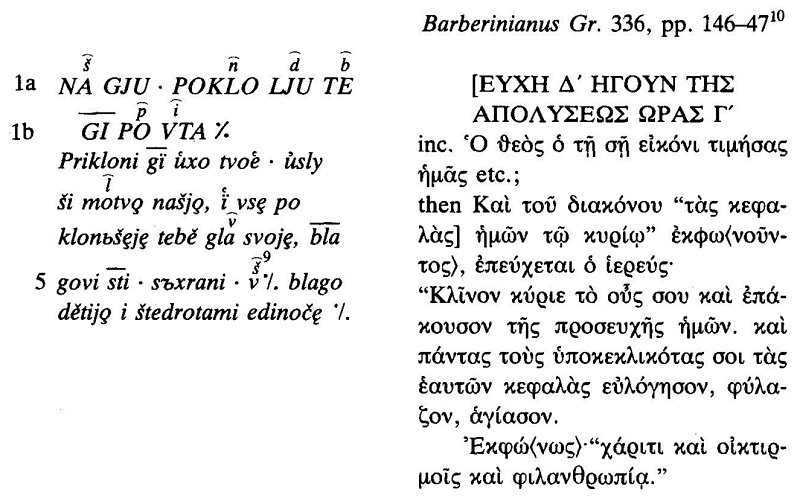
LET US BOW DOWN OUR (HEADS) UNTO THE LORD. PEOPLE: UNTO THEE,
O LORD. PRIEST SEC(RETLY):
O Lord, incline Thy ear, and hear our prayer; and bless,
sanctify, and preserve all those who have bowed down their heads unto Three.
8. For Barberinianus’s Italo-Greek origin, see, e.g.,
A. Strittmatter, “The Barberinum S. Marci of Jacques Goar, Barberinianus
Graecus 336,” Ephemerides Liturgicae 47 (1933): 329-67; and H.
Follieri, Codices Graeci Bibliothecae Vaticanae Selecti. . . (1969),
no. 10 = pp. 19-20; on the same origin of Leningrad, Greek 226, cf. Jacob,
“L’euchologe . . (as in fn. 7 above), pp. 175-76. A. F. Cereteli’s old
opinion that our manuscript is of “Syriac” type should disappear from
secondary literature. Cereteli’s own plate V, 1-2 easily refutes his
hypothesis. Cf. his Paleografičeskie snimki s nekotoryx grečeskix,
latinskix i slavjanskix rukopisej Imp. Publ. Biblioteki (St. Petersburg,
1914), p. 5 and plate V, 1-2.
9. In line 5, the abbreviation = vъzglašenie.
10. This is Strittmatter, “The Barberinum” (as in fn. 8
above), no. 93, published in Arranz, “Les prieres presbyterales” (as in fn.
6 above), p. 39; cf. also Dmitrievskij, Opisanie (as in fn. 7 above),
37 ( = Prayer 5); Jacob, “L’euchologe” (as in fn. 7 above), no. 96 = fol. 57v.

123-131
[[ Plates 1–2; Figures 1–28 ]]

132
Au<dibly>: Through the Grace and Mercy of <Thine> only bego<tten
Son with Whom Thou art blessed, together with Thy Holy and Good and
Life-giving Ghost, now and ever and unto the ages of ages>.
Prayer 2
fol. X, recto, lower half
Beginning of the prayer of the First Antiphon of the Sixth
Hour
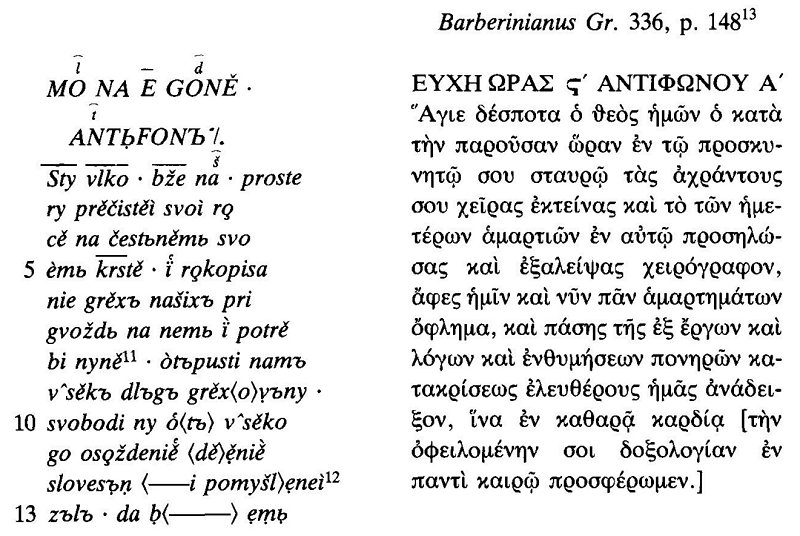
PRAY(ER) AT THE 6 HOUR; ANTIPHON
Holy Lord our God, Thou who didst extend Thy immaculate arms
on Thy venerable cross and didst nail to it the handwriting of our sins and
blot it out; forgive us now all the debt of our sins; free us from all
condemnation < ------------ > evil deeds, words [?] (and) thoughts.
11. In lines 7/8 I conjecture potrěb<ь>, i
nyně — required by ἐξαλείψας (a past participle), καὶ νῦν of the Greek—
as the original reading.
12. In lines 12/13 our text reads .nei zъlъ. The Greek
model has ἐντυμήσεων πονηρῶν in this place. The Slovník Jaz.
Staroslověnského (hereafter SJS), s. v. pomyšlenije, quotes
ἐνθύμησις as one of this word’s equivalents. Cf. also Euchologium
Sinaiticum, ed. Nahtigal (hereafter ES; for full title of the
edition, cf. fn. 31 below), p. 72 a 16: pomyšlenы nepravedně; ibid.,
p. 92 a 5: otъ skvrъnenъ pomyšlenei; Freising Fragments, III,
29: uzeh nepraudnih del i nepraudnega pomislena.
13. This is Strittmatter, “The Barberinum” (as in fn. 8
above), no. 94, published in Arranz, “Les prières presbytérales” (as in fn.
6 above), p. 42; cf. also Dmitrievskij, Opisanie ... (as in fn. 7
above), pp. 37 and 1005; Jacob, “L’euchologe” (as in fn. 7 above), no. 97 =
fol. 58r.

133
Prayer 3
last folio, verso, upper half [14]
Vespers, end of the prayer of the Sixth Antiphon

So that we through Thy (Compas)sion and Thy Mercy; and visit
us through Thy Grace and
14. This prayer occurs in modem Služebniki, e.g., that
of 1857, p. 2v, as prayer 5 rather than 6 in the posledovanie
večerni. For earlier texts, cf. (a) the Novgorod (?) Euchologium of the
fourteenth century owned by Metropolitan Ioan Teodorovyč, facsimile edition
by P. Kovaliv, Molytovnyk: Služebnyk, pamjatka XIV stolittja (New
York, 1960), fol. 37v (as prayer 6; this Euchologium’s text goes
back to that of our fragments), and (b) the printed Služebnik
(Moscow, 1602), V, 2v-3r (cf. A. S. Zernova, Knigi
Kirillovskoj pečati izdannye v Moskve v XVI-XVII vekax [Moscow, 1958],
p. 20 = no. 18; I used the Bodleian Library copy 4° L, 11, Th. BS (this
text, numbered 6, goes back to a reworked, or perhaps new, translation
adhering closely to the Greek).
15. In line 1, <štedrota>mi, a word beginning
on the recto of the last folio, is sure on account of οἰκτιρμῶν of the Greek
model. In the same line, one could also read mlostijο̨
instead of milostijο̨
.
16. In line 8, the abbreviation = vъzglašenie.
17. This is Strittmatter, “The Barberinum” (as in fn. 8
above), no. 56, to appear as no. 60 in the forthcoming edition by Jacob; it
is published in J. Goar, Εὐχολόγιον sive Rituale Graecorum (1647), p.
36 (2nd ed. of Venice [1730], p. 29), and translated in Arranz, “Les prières
sacerdotales” (as in fn. 6 above), p. 93; cf. also Trempelas, Μικρόν (as in
fn. 7 above), p. 251; Jacob, “L’euchologe” (as in fn. 7 above), no. 59 =
fol. 39r, and modern Greek Euchologia (e.g., ed. Zerbos [Venice,
1869], p. 14), where our prayer appears as no. 5.

134
grant that for the rest of this day as well we may escape the
wily [?] contrivances and plots of the Enemy. Preserve our lives through the
Grace of Thy Holy Ghost, etc. Aud<ibly>: Through the Mercy and Love of
Mankind of Thy onl<y-begotten> etc.
Prayer 4
last folio, verso, lower half [18]
Vespers, prayer of the Seventh Antiphon
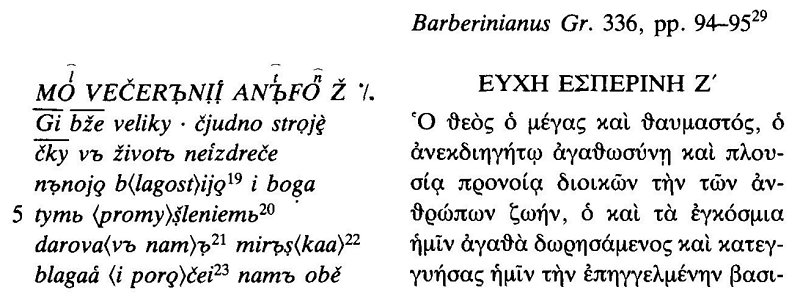
18. A version close to this prayer occurs in modern
Služebniki, e.g., that of 1857, p. 3r, as prayer 6 rather than 7. For
earlier texts, cf. the Euchologium ed. Kovaliv (as in fn. 14 above), fol. 37v-38r
(as prayer 7); Služebnik of 1602 (as in fn. 14 above), V, 3r-3v
(as prayer 7).
For purposes of comparison, I am transcribing our Prayer 4
after these two sources. As in our Prayer 3, the Euchologium ed. Kovaliv,
for all its errors, offers a text going back to our fragments, while the
text of 1602 reflects a reworked (or new) translation closely following the
Greek. This text may represent the redaction of the Služebnik
attributed to Metropolitan Cyprian. Cf., e.g., N. N. Rozov, “Russkie
Služebniki i Trebniki,” Metodičeskie rekommendacii po opisaniju
slavjano-russkix rukopisej dlja svodnogo Kataloga rukopisej . . II, 2
(Moscow, 1976), pp. 315-16; 329 and fn. 20.
Euchologium ed. Kovaliv. fol. 37v-38r:

Služebnik of 1602, Vˉ, 3r-3v:

19. SJS quotes ἀγαθωσύνη as equivalent to blagostь,
but not to blagodětь or blagodatь. The Greek prayer has
ἀγαθωούνῃ at the corresponding spot. Cf. ES, p. 20 b 11/12:
neizdrečeny ( = error!) blagostijo̧.

135
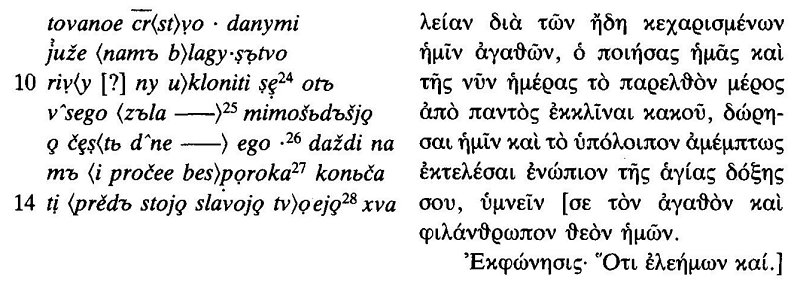
PRAY(ER), EVENING [?] ANTIPHON 7
O Lord great God, Thou who wondrously managest men in life;
Who through
20. The reading in line 5 is assured by προνοίᾳ of the Greek
prayer, usually rendered by promyšlenije, and by bogatymъ
promyšleniemъ in ES, p. 20b 12/13.
21. The reading in line 6 is assured by the Greek (ἡμῖν . . .
δωρησάμενος, a past participle) and by darovavъ namъ of the
Euchologium ed. Kovaliv, fol. 38r (for text, cf. fn. 18 above).
22. Reading suggested by mirskaę in Služebnik
of 1602, Vˉ, 3v (for text, see fn. 18 above) and by ES, p. 90a 2/3
pečalei mirъskyxъ.
23. At first sight, (poro̧)čei
or (izdro̧)čei
seems too short, for the lacuna here is longer than 4 or 5 letters, but the
Greek model of this passage has only καὶ κατεγγυήσας. SJS gives
ἐγγυᾶσθαι ‘give surety’, as one of the equivalents of
poro̧čiti
and izdro̧čιti/ati.
ES, p. 83 b 9 has poro̧čьnikъ,
corresponding to ἐγγυητής. The Euchologium ed. Kovaliv, fol. 38r
has obručivyi, Služebnik of 1602, Vˉ, 3v, poručivъ
(for texts, cf. fn. 18 above). In sum, I opted for
poro̧čei.
24. The reading sъtvorivy (for ποιήσας) is doubtful.
The usual rendering of ποιήσας in ES is sъtvorь or sъtvorei.
Ukloniti sę is sure, since the ἐκκλῖναι of the Greek prayer is
regularly rendered by ukloniti sę.
25. Zъla is assured on account of the Greek and ES,
p. 72 b 26 izbavi mę gˉi otъ v^sego zъla. This word alone seems too
short to fill the gap; yet, the Greek has only κακοῦ, and the Euchologium
ed. Kovaliv, fol. 38r (for text, see fn. 18 above) has vsękogo
zla. mimošedъšaja časti, essentially as in our text.
26. The lacuna after čęs<tь> is difficult to
fill. On account of τῆς νῆν ἡμέρας of the Greek, one would expect <d^ne
nyněštьnjaj>ego (SJS gives ὁ νῦν as a model for nyněštьnъ,
and the Služebnik of 1602 reads nˉnˉešnęgo dnˉe). The lacuna
seems too short for this solution, however. Perhaps our text simply had
d^ne sego, as the Euchologium ed. Kovaliv, fol. 38r does (for
texts, cf. fn. 18 above).
27. The reading in line 13 is assured by the Greek model
which has καὶ τὸ ὑπόλοιπον ἀμέμπτως. For pročee, cf. our folio (X +
A) verso, line 5, and ES, p. 83 b 18 i pročee života moego,
where it stands for ὑπόλοιπον of the Greek. For bes poroka = ἀμέμπτως,
cf. SJS s.v. porokъ. Bes poroka occurs in ES, p.
98a 22/23. Finally, the Euchologium ed. Kovaliv, fol. 38r has
dažь namъ pročeje bes poroka sxraniti (for full text, cf. fn. 18 above).
28. The reading in line 14 is based on the ἐνώπιον τῆς ἁγίας
δόξης σου of the Greek prayer and on the two East Slavic parallel witnesses
of fn. 18 above. There, the Služebnik of 1602 has
pred
st̅oju
slavoju ti,
while the prest̅uju
slavu tvoju
of the Euchologium ed. Kovaliv must be an error for
prědъ
st̅oju
slavoju tvojeju.
29. This is Strittmatter, “The Barberinum” (as in fn. 8
above), no. 57, to appear as no. 61 in the forthcoming edition by Jacob; it
is published by J. Goar, Εὐχολόγιον (1647), pp. 36-37 (2nd ed. of Venice
[1730], p. 29), and translated in Arranz, “Les prières sacerdotales” (as in
fn. 6 above), p. 94; cf. also Trempelas, Μικρόν (as in fn. 7 above), p. 252;
Jacob, “L’euchologe” (as in fn. 7 above), no. 60 = fol. 39v, and
modern Greek Euchologia (e.g., ed. Zerbos [Venice 1869], p. 15), where our
prayer appears as no. 6.

136
inexpressible go<odn>ess and bounteous <pro>vidence hast
bestowed upon us the good things of the world <and> <pled>gest to us the
promised Kin<gd>om through the good things Thou hast given <us> already; Who
hast cause<d us to a>void all <evil > in the pa<rt of day> that has passed
by; grant that we may also complete without blame that which remains of it
<in the face of T>hy <holy glory>; to prai<se>
II
How should we assess the Slavic translations? The answer is
that, on the whole, the Slavic faithfully follows its original but sounds
natural at the same time — thus it displays a trait that is characteristic
of the earliest translations. In the prayers of the Sixth Hour and of the
Seventh Antiphon, the translations are freer than elsewhere; they do not
follow the word order of the Greek, and in spots tend to be paraphrases.
That is why I was unwilling to fill in all the gaps in the Slavic text in
spite of having its Greek model at my disposal.
Let us single out some discrepancies between original and
translation in the prayer of the Sixth Hour ( = Prayer 2). In line 2, the
words ‘at the present hour’ of the Greek are omitted in the Slavic. In line
4, the epithet προσκυνητῷ ‘adorable’, referring to the cross, is replaced by
the more familiar čestъněmь, which usually corresponds to τίμιος
‘venerable’. In lines 6/7, prigvoždь ‘having nailed down’ is a past
participle, rendering the Greek participle προσηλώσας. The parallel
potrěbi ‘blot (or blotted) out’, in line 7 is not a participle, however,
even though its Greek equivalent ἐξαλείψας is. To restore the
correspondence, I conjecture potrěbь, i ‘having blotted out,
and’ as the original reading; this fits the Greek well, especially since we
need an i before nyně to correspond to the καὶ νῦν of the
Greek. Finally, in line 10 we read the imperative svobodi ‘free’,
which is simple but adequate, whereas the Greek has the more ponderous
ἐλευθέρους ἡμᾶς ἀνάδειξον ‘proclaim us free’.

137
Before going any further, let us say a word about the verso
of the hardly visible folio, which I shall call “folio (X plus A) verso”
(fig. 1). Only a few words on that folio are legible. We realize, however,
that the first four visible lines are the end of a prayer, and that the
penultimate legible line is the beginning of another prayer. The two capital
letters, of which only the azъ is surely legible, indicate that a
title is standing in between. If folio (X plus A) verso is connected with
the last folio of our fragment, it must contain some earlier prayers of the
beginning of the Vespers. There are, in fact, some similarities between the
visible words of that folio and the Greek texts of the prayers of the Second
and Third Antiphon of the Vespers. [30] There is no need to belabor the
point, however, because sooner or later some scholar will inspect the whole
fragment and put an end to the guessing. In the meantime, I am offering the
transliteration of the visible part of folio (X + A) verso ( = Prayers 5 and
6).
Prayers 5 and 6
fol. X + A verso, visible part
Vespers? Parts of Prayers of the Second and Third Antiphons?
(line numbers correspond to the lines of the last folio, verso of the
fragments)

30. For Greek texts, cf., e.g., I. Goar, Εὐχολόγιον sive
Rituale Graecorum, 2nd ed. (Venice, 1730), pp. 28-29 and 163-64;
Trempelas, Μικρόν (as in fn. 7 above), pp. 249 and 250.

138
III
We now turn to the search for the manuscript to which our
fragment once belonged. I need not be a Sherlock Holmes to realize that
another Sinai manuscript should be the prime suspect. Almost all available
indicators point to the Glagolitic Euchologium Sinaiticum (ES),
one of the oldest Slavic manuscripts in existence, still kept on Sinai.
[31]
We may start with external indicators. The first is the similarity in
general appearance, let alone the similarity of initials (plate 1 and figs.
2 and 3, pp. 123, 125); the second, close similarity in dimensions — the
ES measures 140 x 105 mm. and our fragment measures 148 x 105 mm.; the
third is the fact that the ES is mutilated at the beginning, so that
there is “room” for putting our fragment into its lost front part — in Greek
Euchologia, this first part of the volume is liturgical and includes the
very prayers contained in our fragments; the fourth indicator is the fact
that other fragments securely or putatively connected with the ES
have been taken from Sinai in the past — two leaves by Uspenskij in 1853,
one by Krylov in the same year, and one by Kondakov in 1881. [32] This shows
that some loose leaves of that Euchologium were lying around in the
nineteenth century, possibly in the very room where the new fragment was
found, for that room served as a depository for damaged and disused material
until the beginning of our century. Also, the fragments obtained by
Uspenskij and possibly those brought by Krylov were from the first, or
liturgical, part of the Euchologium, the very part into which our
fragments would fit quite well.
31. Recent editions:
·
J. Frček, Euchologium Sinaiticum I-II, in
Patrologia Orientalis 24, 5 (1933, reprint 1974) and 25, 3 (1939,
reprint 1976) [Greek parallels, French translation];
·
R. Nahtigal, Euchologium Sinaiticum, in Akademija
Znanosti in Umetnosti v Ljubljani, Filozof.-filol.-hist. Razred, Dela,
1-2 (Ljubljana, 1941-42) [Facsimile; edition with commentary, bibliography].
Glossary:
·
S. Sloński, Index verborum do Euchologium Sinaiticum
(Warsaw, 1934).
Succinct bibliography in
·
F. Sławski, art. Modlitewnik Synajski, in Słownik
Starożytności Słowiańskich 3, no. 1 (1967): 272-73. Cf. also
·
Dostál, “L’eucologe slave du Sinai,” Byzantion 36
(1966): 41-50;
bibliographies in articles by
·
E. Dogramadžieva and P. Penkova in Slovansko Jazikoslovije,
Nahtigalov Zbornik (1977), pp. 47-66 and 375-87; and
·
R. Mathiesen in the next note.
32. Cf. Frček, Euchologium . . . I-II (as in the
preceding fn), pp. 612-17;
E. E. Granstrem, Opisanie russkix i slavjanskix
pergamennyx rukopisej . . . (Leningrad, 1953), p. 78 (on Glag. 3, i.e.,
the Kondakov fragment) and pp. 78-79 (doubts that the Krylov fragment
belongs to the ES); cf. also R. Mathiesen, “Uspenskij’s Bifolium and
the Chronology of Some Early Church Slavonic Translations,” to appear in the
Festschrift for Moshe Altbauer.

139
Two internal indicators, too, point in the direction of the
ES. The first of them is the quasi-identity of the hands in both
manuscripts; the second, correspondences in morphology, [33] vocabulary,
[34] phraseology, [35] and spelling, such as the consistent differentiation
between e and je. Given the great similarities between the two
documents, I relied on the ES in reading the difficult spots on the
fragments’ photographs and in my reconstructions of the damaged parts of the
text.
Should we, then, view our fragments as belonging to the ES
and assign them somewhere to the now lost beginning of that manuscript? In
all probability, yes. Out of scholarly scruple, however, I will mention
three features that must be explained before we definitely incorporate our
fragment into the ES. The first of these is the apparent difference
in the number of lines in both documents. The second is a slight difference
in the tracing of the big initials, the big initial for slovo being
always empty inside in the ES (contrast plate 1 with fig. 4, p. 125);
and the third, the sequence of prayers in the fragments. The fragments have
the Hours prayers first and the Vespers prayers afterwards. This is the
exact opposite of the sequence found in all the early Greek Euchologia known
to me. Thus, in the Barberinianus the two prayers of the Hours on
folio X recto of the fragment are numbered 93 and 94, while the two prayers
of the Vespers on the last folio verso are numbered 56 and 57. In the
catalogue of the Leningrad Euchologium, the respective numbers are 96 and 97
for the Hours and 59 and 60 for the Vespers. Thus what appears to be later
in our fragments is earlier in the Greek Euchologia, provided, of course,
that we have correctly established the sequence of the folia. [36]
33. Cf., e.g., daždi, Prayers 3, 3 and 4, 12, which is
the only imperative form of the second person singular in the ES.
This feature of ES has been singled out by H. G. Lunt, Old Church
Slavonic Grammar, 6th ed. (The Hague, 1974), 16.22 = p. 122.
34. Only seven or eight words or signs for numerals of our
fragments are not attested in ES. They are provided with an asterisk
in the index verborum at the end of this article.
35. Cf., in addition to parallels quoted in notes 19, 20, 22,
25, 27 above, ro̧kopisanie
grěxъ našixъ,
Prayer 2, 5-6, with moixъ grěxъ . . . ro̧kopisanie
ES, 83 b 17; and otъ nastojęštaago d^ne, Prayer 3, 4-5
with the same three words in ES, 89 b 22.
36. For sequences in the Barberinianus and in the
Leningrad Euchologium, cf. fns. 10, 13, 17, 29 above. To obtain the sequence
(a) prayers of the Vespers, (b) prayers of the Hours, for our fragments, we
would have to refold our two folia the other way (with our first folio recto
becoming the last folio recto, and the present last folio verso becoming the
first folio verso) and assume that they once formed the inner part of the
outermost bifolium of a quire, or better yet, of a quinio
(this to accommodate some 37 prayers in between our prayer 4 and our prayer
1). Again, all speculation is idle at this point, for inspection on the spot
will one day provide the answer.

140
If we have, we may venture a reason for this discrepancy. The
early Greek Euchologia start with the Vespers and proceed to the Hours. The
sequence is different in the early Greek Horologia. There, the Hours precede
the Vespers, as they do in our fragments. So, while there is a 95 percent
likelihood that our fragments belong to the ES, we should keep in
mind the 5 percent possibility that they may come from some twin manuscript,
say a Horologion.
IV
The conveyance of the Sinai Glagolitic fragments to Europe by
Uspenskij and Krylov in the past century did cause a small sensation among
Slavicists; later on, controversy ensued as to whether these fragments, by
then available to European scholars, did or did not belong together with the
faraway ES. [37] Today, some forty years after the appearance of the
facsimile edition of the entire ES by Nahtigal, Slavicists are more
blase, but not blase enough to forget how exiguous is the body of earliest
Slavic non-scriptural texts. Therefore, the new find will be welcomed by
friends of Old Church Slavonic literature and Slavic linguistics, both in
Bulgaria and elsewhere, as well as by liturgiologists. For the sake of
Slavicists I report that our fragments do bring some new information. They
offer the word bystrъ — strangely enough, attested in only one other
Old Church Slavonic “canonical” manuscript, the Suprasliensis — with
a hitherto unknown meaning of “wily” or “cunning” (Prayer 3, 5); they may
provide the positive form of the adverb čjudno (Prayer 4, 2),
otherwise unattested in the Old Church Slavonic canon; they enable us to add
a couple of hitherto unknown Greek equivalents of known Old Church Slavonic
words; [38] and they contain some new material illustrating the use of the
jers.
All these points, however, are minor technicalities.
37. For the history of the controversy, Frček, Euchologium
. . . I-II (as in fn. 31), pp. 614-16.
38. A word of caution on čjudno: in view of the
masculine θαυμαστός of the model, it may be an error for čjudnъ, or čjudne
(voc. sg.). — New equivalents: in addition to bystrъ = ποικίλος, we
have neizdrečenъno̧jo̧,
Prayer 4, 3/4 = ἀνεκδιηγήτῳ, and mirъs<kaa>, Prayer 4, 6 =
none of these equivalents is attested in SJS.

141
I wish to touch now upon a broader issue connected with the
new find and ask: what were the models used for the make-up and ornament of
early Glagolitic manuscripts?
V
The textual sources of our fragments are all Greek; let us
call them eastern. When it comes to the fragments’ ornament and general
make-up, however, the models that can best be postulated — or, at least, the
closest parallels that can be adduced — are western, namely, Italo-Greek. As
our fragment and the ES are either the same thing or are twins, I
shall use both of them as evidence. In the juxtapositions that follow, I
made every effort to limit Italo-Greek comparisons to well-known manuscripts
that are precisely dated between the ninth and the eleventh centuries and
are expressly localized in Italy. While I will miss some good parallels
because of this limitation, I will be able to avoid arguments as to whether
an example I adduced is or is not South Italian. Understandably, as points
of comparison, I have chosen features prevalent in Italo-Greek manuscripts
but either rare in other Greek manuscripts, especially Constantinopolitan,
or altogether absent from them.
In a nutshell, parallels between the two groups of
manuscripts extend to,
·
first, the habit of putting a layer of yellow, reddish or
green paint over which titles, rubrics, or initials are written — this was
done to help the reader find the right place (plate 1 and figs. 5-6, pp.
123, 126). The same function could be performed by drawing a line across a
title (fig. 7, p. 126).
·
The second parallel is the use of inordinately large
initials; such giants are absent from Constantinopolitan manuscripts (figs.
8-12, pp. 126-127). Like their Latin counterparts (fig. 13, p. 128), these
initials sometimes “eat into” the body of texts, rather than stand outside
of it (figs. 14-15, p. 128). The Italo-Greek initials are not only large,
but also of a shape unusual in Byzantium proper, yet they are paralleled by
Glagolitic initials (figs. 16-17, pp. 128-129).
·
Third, the parallels between Italo-Greek and Glagolitic
manuscripts include the use of wide interlaced bands or headpieces to
separate parts of texts or to surround titles (figs. 18-19, p. 129).
·
Fourth, they include the use of narrow braided bands for
separation purposes (figs. 20-21, pp. 129-130).
·
The fifth set of parallels has to do with ornamental features
in the initials that are identical in both series of manuscripts.

142
I shall single out two such features: first, the S-shaped
ornaments within initials (figs. 22-23, p. 130), and second, the use of eyes
or animal heads with eyes and beaks as parts of the make-up of initials
(figs. 3, 24-25, pp. 125, 130-131).
·
The sixth point has to do with similarities in the color
scheme between Italo-Greek and Glagolitic manuscripts, especially with the
presence of greens in both groups.
Unfortunately, the reader must accept this point on faith,
because I am not able to reproduce any of the numerous examples of “early
Glagolitic” greens — starting with the green of our fragment — in color and
compare them with the greens of Italo-Greek manuscripts, such as, to quote
an example, the Leningrad Greek 71, copied in Salerno in 1019-20; nor am I
able to show combinations of yellow and ochre, non-typical for Byzantium
proper, but occurring in such Gospel texts as Athens, National Library 74
(an Italo-Greek witness) and the Codex Assemanianus, respectively.
[39]
This evidence suggests that Italo-Greek manuscripts offer the
closest parallel to the make-up and ornament of at least one early
Glagolitic witness, namely, the ES (if we consider our fragments as a
part of that manuscript), or of two witnesses (if we consider these
fragments as a part of a twin manuscript). However, I find my observation
applicable to other witnesses as well: to the Codex Zographensis
(fig. 26, p. 131), to the Psalterium Sinaiticum (fig. 27, p. 131) and
to the Codex Assemanianus (fig. 28, p. 131) — in short, to the
majority of the earliest Glagolitic manuscripts. In other words, I am
suggesting that the habits of the producers of the earliest books written in
Old Church Slavonic reflect South Italian influences.
The proposition that an artistic influence emanated from
South Italy towards the Balkan Slavs is paralleled by André Grabar’s recent
hypothesis according to which Italo-Greek illuminated manuscripts of the
period influenced one aspect of the practice of illumination in Byzantium
itself. [40]
39. For a color reproduction of Athens, Nat. Lib. 74, fol. 1v,
cf. A. Marava-Chatzinicolaou and Ch. Toufexi-Paschou, Catalogue of the
Illuminated Byzantine Manuscripts of the National Library of Greece,
vol. 1 (1978), fig. 74; for its initials in color, cf. ibid., figs. 76-79;
for its braided headpieces, cf. figs. 82 and 85. For a color facsimile of
the Codex Assemanianus, cf. now Asemanevo evangelie, faksimilno
izdanie (Sofia, 1981), e.g., fols. 12v, 13r, 13v,
23r, 31v, 44r, 49v, 51v,
55r.
40. Cf. A. Grabar, Les manuscrits grecs enluminés de
provenance italienne (IXe-Xe siècles)
(Paris, 1972), pp. 96-97; Italo-Greek manuscripts transmitted the Western
composite initial to Byzantium (but not the “Latin” ornaments or the
“colossal” initials with which we are dealing here; cf. ibid., pp. 92-93).
Addendum to fn. 40: — J. Leroy, “Notes codicologiques sur le
Vat. gr. 699,” Cahiers archeologiques 23 (1974): 73-79,
considers (p. 76 and fn. 25) initials containing a twisted cord to be
characteristic of Italo-Greek manuscripts (cf., e.g., our fig. 10). Many
initials in both the ES and other Glagolitic manuscripts are
decorated in the same way (cf. our figs. 2 and 26). — For interlaced bands
in the Italo-Greek manuscripts, cf. now E. Follieri, “Due codici greci. . .
Ottob. gr. 250 e 251,” in Palaeographica Diplomatica et Archivistica,
Studi in onore di Giulio Battelli (Rome, 1979), pp. 159-221, especially
figs. I and VI.

143
Thus my suggestion should appear less startling to an art
historian than it might to a Slavic philologist, whose main points of
reference for our period are Byzantium, Macedonia, Bulgaria, Moravia, and
the Franks. Nor is it, strictly speaking, novel, for in recent years,
connections were occasionally established between Italo-Greek and early
Slavic illumination and ornament. But these were obiter dicta,
dealing with individual Greek or Slavic manuscripts, such as the few well
chosen words on the ES and the Sinai Psalter by Kurt Weitzmann whose
broad knowledge of East and West enabled him to put these manuscripts in
their proper framework; [41] Guillou’s and Tscheremisinoff’s
well-intentioned attempt based on an inappropriate example; [42]
41. Kurt Weitzmann, Illustrated Manuscripts at St.
Catherine’s Monastery on Mount Sinai (Collegeville, Minnesota, 1973), p. 13.
42. Cf.
·
Guillou and Katia Tcheremisinoff, “Note sur la culture arabe
et la culture slave dans le katepanat d’ltalie (Xe-XIe
s.),” Mélanges de I’Ecole française de Rome 88 (1976): 677-92,
especially 685-90,
repeated with only a few changes in
·
Guillou, “La culture slave dans le katepanat d’ltalie,”
Slavjanskie Kul’tury i Balkany (Sofia), 1 (1978): 267-74.
In both articles, the general cultural background is drawn
with a master’s pen; and the connection (made in the wake of Weitzmann)
between the ES, the Sinai Psalter, and South Italy is to be applauded
(even if, pace p. 690, these manuscripts were hardly written
in South Italy); however, the main new piece of manuscript evidence adduced
by the authors — namely, Athens, National Library 149 (Acts of the Apostles
and the Epistles, rather than “Psalter”) — does not quite belong in our
context.
True, the text of the manuscript itself, its original
rubrics, headpieces and simple initials, are unmistakably by a South Italian
scribe of the late tenth or early eleventh century. But all the titles in
black ink are either added in spaces left empty by the original scribe, or
rewritten over the original rubrics: cf. fols. 56v-57r,
where the original title of 57r, + ΥΠΟΘΕΣΙΣ . . . ΤΗΣ ΔΕΥ, still reflected
in mirror image on fol. 56v, was erased, and a Greek title in
black ink by a “Slavicizing” hand substituted for it.
-
This hand is, however, to be dated to the fourteenth century;
-
so are the Slavic titles and texts on scrolls, probably
written by the same hand;
-
so are the three miniatures of St. Peter and Paul.
-
The spelling of the Slavic on the scrolls, too, points to the
fourteenth century (and perhaps to Serbia);
-
the paschal tables of fol. 159r start with the
year 1328;
-
finally, the manuscript itself reached the Athens National
Library from Bačkovo in Bulgaria.
Thus Athens, National Library 149 is not a witness, along
with the two early Glagolitic manuscripts from Sinai, for Slavic scribal and
artistic activity and bilingual culture somewhere in South Italy in the
first half of the eleventh century; it reflects the activity of some center,
situated in the Balkans in the fourteenth century, where a Slavic scribe
mastered Greek script reputably well, and where bad miniatures were
attempted. I am able to make only one valid statement of use to our topic in
connection with the Athens manuscript: this manuscript attests to the
movement of books from South Italy to the Balkans sometime between the
eleventh and fourteenth century.
For a description of the Athens, National Library 149, cf.
·
Marava-Chatzinicolaou and Toufexi-Paschou, Catalogue
(as in fn. 39 above), no. 8 = pp. 51-55 and figs. 62-71.
Slight doubts that the Slavic miniatures of this manuscript
are of the same period as its text were already expressed by
·
Grabar, Les manuscrits grecs (as in fn. 40 above), 68
(with the assistance of L. Vranoussis).

144
or a stray remark or two drowned among a plethora of guesses
on Codex Assemanianus’s putative connections ranging from Coptic to
Mycenaean. [43] What, I submit, is novel in my suggestion is that it points
to a link between the bulk of the earliest Old Church Slavonic production
and Byzantine Italy. [44]
Studying the make-up and ornament of ninth-to-eleventh
century Italo-Greek manuscripts may be of help in narrowing down the date of
their Glagolitic counterparts, including our newly discovered fragments from
Sinai. Comparison with Italo-Greek manuscripts strengthens the impression
that these fragments are not later than the end of the eleventh century;
they could be even earlier.
43.
·
V. Ivanova-Mavrodinova and L. Mavrodinova, “Ukrasata na
starobъlgarskite glagoličeski rъkopisi,” in Paléographie et diplomatique
slaves [ = Balcanica III, Etudes et documents, 1] (Sofia, 1980), trace
(p. 195):
“a few” examples of ornament in the ES go back to
Greek manuscripts from South Italy;
·
V. Ivanova-Mavrodinova and A. Džurova, Assemanievoto
evangelie. Starobъlgarski glagoličeski pametnik ot X vek [ = a companion
volume to the facsimile edition of the Codex] (Sofia, 1981),
reproduce (p. 32) a passage from Weitzmann (as in fn. 41
above), state (pp. 19, 20), on evidence unknown to me, that some textual
traits of the Assemanianus are paralleled in Greek manuscripts from
South Italy, and admit (p. 42) in the Assemanianus the existence,
“though to a small degree,” of elements similar to those of some western
manuscripts.
Otherwise, the authors range widely in their search for
artistic sources of that manuscript. Their preferences go to Bithynia (about
whose ninth-century securely dated and localized illuminated manuscripts we
know next to nothing), on the strength, I assume, of Cyril and Methodius’s
stay in the Mt. Olympus region there and on account of the “Bithynian
Milieu” cautiously postulated by Kurt Weitzmann in 1935 on the basis of one
non-illuminated ornamented manuscript; cf. his Die byzantinische
Buchmalerei . . . (Berlin, 1935), pp. 39-44 (incidentally, the Bithynian
manuscript in question seems to have been written in Kios-Gemlik, rather
than in the unknown diocese τῆς βίου; in any case its ornament has nothing
to do with either Glagolitic or South Italian ornament); to Cappadocia; to
Syria-Palestine; to “Greek-Oriental Provinces,” or to late Antiquity in
general. Much of it repeats the conceptions, and the terminology, of before
1914.
Yet even an untrained eye is struck by the western crown
within the initial for V on fol. 74v of the Assemanianus.
Furthermore, the Cyrillic entry on fol. 146b that mentions the feast of
Saint Nicholas under May 20 (a “western” date, conditioned by the
translation of the saint’s relics to Bari in South Italy) should give food
for thought.
44. Systematic work on ornaments in early Cyrillic
manuscripts is still to be done. The examples offered by the old, but
excellent plates in
·
V. V. Stasoff ( = Stasov), Slavjanskij i vostočnyj
ornament po rukopisjam drevnjago i novago vremeni (St. Petersburg, 1887)
suggest that the ornament and initials in the early
(eleventh-twelfth centuries) Cyrillic manuscripts are close to the “South
Italian” ornaments of early Glagolitic ones.
Cf. plates
-
I, 3 (Rumjancev Museum 961, fol. 2: braided band; red, green,
yellow colors);
-
I, 24 (Codex Suprasliensis, Ljubljana part), fols. 8
and 42 (braided bands);
-
II, 1 (Rumjancev Museum 1690, fol. 68: wide interlaced
headpiece);
-
II, 2 (ibid., fol. 88: narrow interlaced band);
-
II, 17 (ibid., fol. 55v: letter B with eye and beak);
-
III, 1 (Rumjancev Museum 1685, fol. 26v: band with the
S-motif);
-
III, 2 (ibid., fol. 34: interlaced band);
-
III, 4 (ibid., fol. 5V: interlaced band with the S-motif);
-
III, 26 (ibid., fol. 2V: three S-motifs in letter B).

145
I am not able to go beyond this guess in terms of absolute
chronology. I do have a tentative idea, however, concerning the relative
chronology of the main Glagolitic manuscripts. Again, I derive this
chronology from their make-up and ornament, and am suggesting that our
fragments, the ES, and the Zographensis come first, followed
by the Psalterium Sinaiticum and the Codex Assemanianus, in
that order. Thus, the Assemanianus would be the youngest, rather than
the oldest, among the early Glagolitic manuscripts. This sequence runs
counter to views prevalent in the secondary literature, but coincides with
the most recent, and still unpublished, opinions of some Slavic linguists.
[45]
There are several ways of interpreting the parallels in
ornament between the Italo-Greek and early Glagolitic manuscripts. I give
low priority to postulating common sources of influence for the two, because
South Italian parallels alone explain matters in a better, and simpler, way
than any such postulated sources, be they transalpine (whether insular or
Carolingian) [46] or
45. In the standard edition of the Assemanianus by J.
Vajs and J. Kurz, Evangeliarium Assemani, Codex Vaticanus Slavicus glag.,
. . . vols. 1 and 2 (Prague, 1929 and 1955) our manuscript is dated to the
end of the tenth and the beginning of the eleventh century; cf. vol. 1, p.
VII and vol. 2, p. VII. In the two works quoted in fn. 43 above (and in
other recent Bulgarian publications, too numerous to be adduced here), the
Assemanianus is said to be the earliest Old Bulgarian Glagolitic
manuscript known to scholarship and is dated to the years 950-980, cf.
Ivanova-Mavrodinova and Mavrodinova, pp. 190, 193; Ivanova-Mavrodinova and
Džurova, pp. 11, 19, 23, 25, 56, 57, 65. The chronological sequence, based
on ornament and proposed by the two Mavrodinovas (p. 193), is as follows:
1. The Assemanianus; 2. The Zographensis and
the Marianus; 3. The ES; 4. The Psalterium Sinaiticum.
Professor Horace G. Lunt obtains the first rank among the
linguists most recently advocating a late date for the Assemanianus.
He considers it to be “surely the youngest” of the Old Church Slavonic
gospel manuscripts and dates it to the second half of the eleventh century,
or even to 1100. Cf. Lunt’s three forthcoming studies:
-
“On the Old Church Slavonic Codex Assemanianus,” to appear in
Makedonski jazik (Skopje);
-
“On OCS Gospel Texts,” to appear in Byzantinobulgarica
(Sofia), and
-
“On Dating Old Church Slavonic Gospel Manuscripts,” to appear
in Studies in Slavic and General Linguistics (Utrecht, 1982).
Professor Robert Mathiesen, too, doubts the early date of the
Assemanianus (communication by letter).
All artistic and linguistic considerations aside, the
mid-tenth century date for the Assemanianus is unlikely on account of
the mention of Theodora of Thessalonica in its synaxarium (fol. 152v).
As the Greek Theodora died in 892, her inclusion into a Slavic Synaxarium a
mere sixty years after her death would be unusual.
46. Grabar, Les manuscrits (as in fn. 40 above), pp.
82-93, has listed Carolingian and insular influences in Italo-Greek
manuscripts (influences reaching South Italy either directly, or through the
mediation of Northern Europe or, finally, the city of Rome). It is
impossible to show, for lack of evidence, direct Carolingian or insular
influences on the earliest Slavic manuscripts produced, say, in Moravia or
the area in which Methodius was active. Such influences would be possible to
imagine; but could a tradition of illumination be created in a maximum of
twenty years, to live on after direct contacts with the Franks had been
interrupted?

146
“Oriental” (read Syro-Palestinian). [47]
A higher priority should be assigned to historical and
cultural explanations. The first is offered by channels for contacts between
the Balkans and Italy. [48] The second explanation would postulate the
existence of a Slavo-Greek milieu in late ninth-century Rome. [49] A third
would deal with the missionary activity originating in Italy and spreading
to the Balkans in the ninth century, [50] even if in our search for traces
of the movement of people and books from South Italy across the Adriatic we
should go beyond the earliest period and keep the tenth and eleventh
centuries in mind as well.
In pursuing those explanations, we should consider the
ornament of Glagolitic manuscripts as a “tracer” for contacts, [51] and
47. Ivanova-Mavrodinova and Džurova, Assemanievoto (as
in fn. 43 above), p. 42, assert that similarity of ornamental elements in
the Assemanianus and some western manuscripts, respectively, is due
to the “elementary truth” that Syro-Palestinian and Coptic elements played a
role in the formation of Western art. Cf. also ibid., p. 61 and p. 62 where
— in seeming disregard of geography — common (Syriac and “Egyptian”) models
are adduced to explain similarities between Italo-Greek and the nearby
Croatian Glagolitic manuscripts.
48. For an excellent, if short, statement on these contacts,
cf. the two articles by A. Guillou quoted in fn. 42 above, with good
bibliography (including studies by I. Dujčev and Guillou himself); cf. also
the bibliography in A. Guillou, “L’ltalie byzantine au XIe
siècle. Etat des questions,” in L’art dans l’Italie meridionale,
aggiornamento dell’opera di Emile Bertaux . . . (Rome, 1978), p. 3ff.
49. If we could enlarge our meagre body of information on
this milieu, we would move a long way towards explaining the familiarity
with the ecclesiastical topography of the city of Rome, and with Roman
affairs, displayed in the Vita of Constantine, Apostle of the Slavs.
Whoever wrote the Vita knew Rome quite well.
50. This is more of a stab in the dark than an explanation.
On missionary activity from the west, including impulses from Italy, cf. F. Dvornik, Byzantine Missions among the Slavs . . . (New Brunswick,
1970), especially chap. 3, pp. 73-104 and 346-62.
51. Peculiarities of texts preserved in the earliest Glagolitic manuscripts would be the best “tracers.” Here, analysis has not
progressed beyond general statements concerning the “western,” i.e., Latin
elements (read: Vulgate elements and Hebrew ones that had entered the Latin
West) in the early Slavic translations of the Lectionary and the Psalter.
Again, the term “western” turns scholars’ minds either to mixed Byzantine
models (thought to have absorbed those Latin and Hebrew elements), or to
Moravia, where reworkings by Slavs are said to have been done under Latin
influence.
Cf.
·
Vajs-Kurz, Evangeliarium (as in fn. 45 above), I:XXV,
and
·
J. Lepissier, “La traduction vieux-slave du psautier,”
Revue des Etudes Slaves 43 (1964): 59-72, especially 72.
I know of only one scholar who connects the text of an early
Glagolitic manuscript with Italy: according to Guillou-Tscheremisinoff,
“Note” (as in fn. 42 above), p. 690, fn. 6, A. Jacob found that some prayers
of the ES were “composed with the help of Italo-Greek manuscripts.”
Unfortunately, Dr. Jacob’s findings, “in press” by 1976, are still
inaccessible to me.

147
should add Byzantine Italy to Byzantium and the Latin West in
our list of main areas from where cultural influences entered the Balkans
between the ninth and eleventh centuries. Such a vast topic can be only
suggested, but not responsibly tackled in a first presentation of a mere two
pages of an early Glagolitic manuscript. May this presentation meet with the
approval of the Sinai authorities, and help expedite their plans to proceed
with the full publication of the new finds, both Glagolitic and Cyrillic,
that were made in their monastery.
Harvard University
[[ Photo credits (p. 147) and APPENDIX. Index Verborum to
the Sinai Fragments (pp. 148-151) are in the
.pdf file ]]
Plates and figures:
.

Plate 1: Sinai fragment, folio X recto.

124
.

Plate 2: Sinai fragment, last folio verso.

125
.
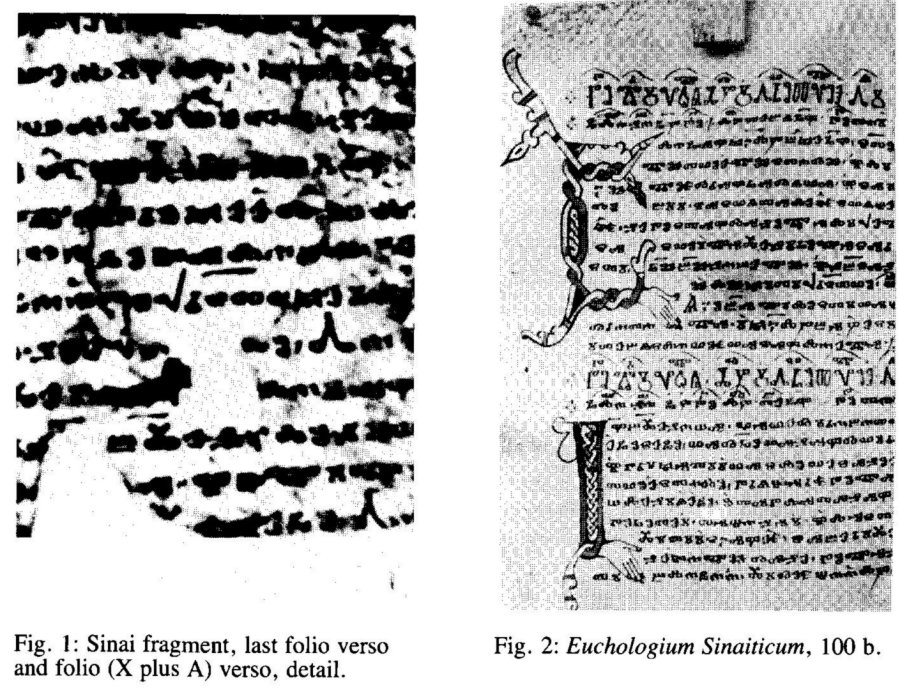
Fig. 1: Sinai fragment, last folio verso and folio (X plus A)
verso, detail.
Fig. 2: Euchologium Sinaiticum, 100 b.
.
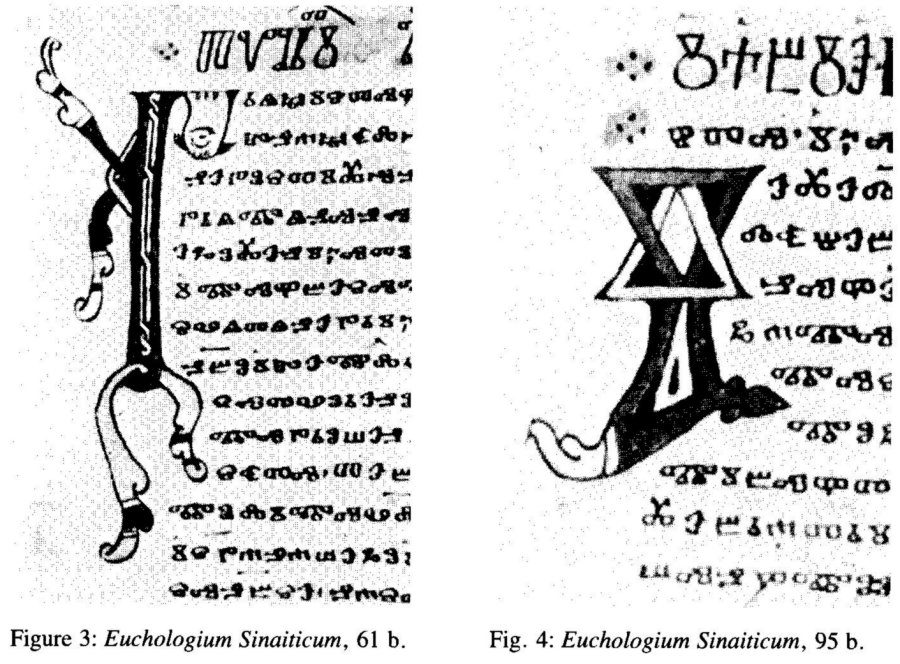
Fig. 3: Euchologium Sinaiticum, 61 b.
Fig. 4: Euchologium Sinaiticum, 95 b.

126
.

Fig. 5: Cryptoferratensis B. a. IV, fol. 145r
(a. 991).
Fig. 6: Vaticanus Reginensis Gr. 75, fol. 49r
(ca. a. 983).
.

Fig. 7: Oxoniensis Bodl. Laud Gr. 75, fol. 326v.
(a. 976).
Fig. 8: Vaticanus Gr. 2138, fol. 35r (a.
991).

127
.

Fig. 9: Oxoniensis Bodl. Gr. 204, fol. 17r.
Fig. 10: Vaticanus Gr. 2138, fol. 3v and 26r
(a. 991).
.
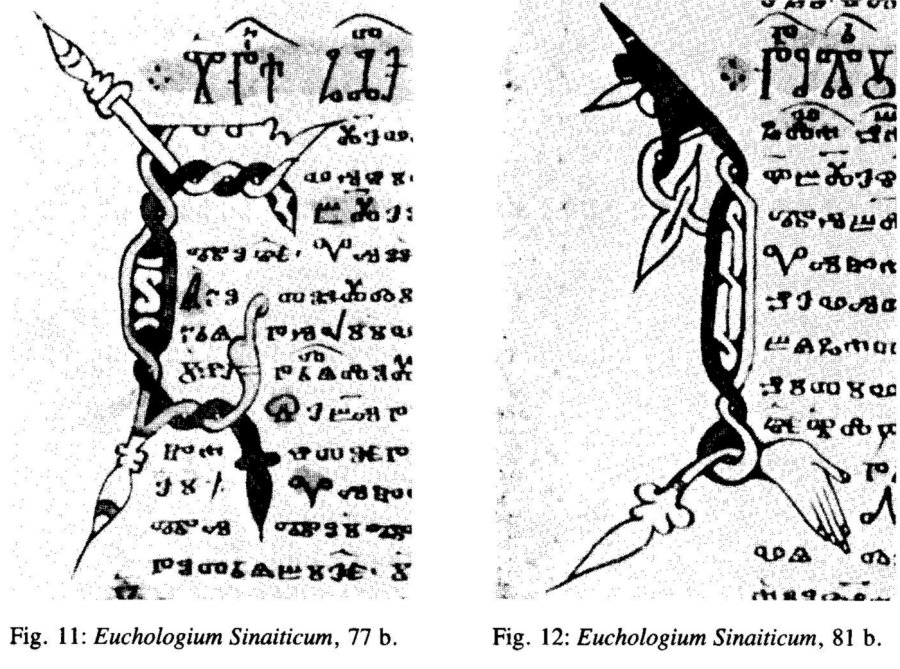
Fig. 11: Euchologium Sinaiticum, 77 b.
Fig. 12: Euchologium Sinaiticum, 81 b.

128
.
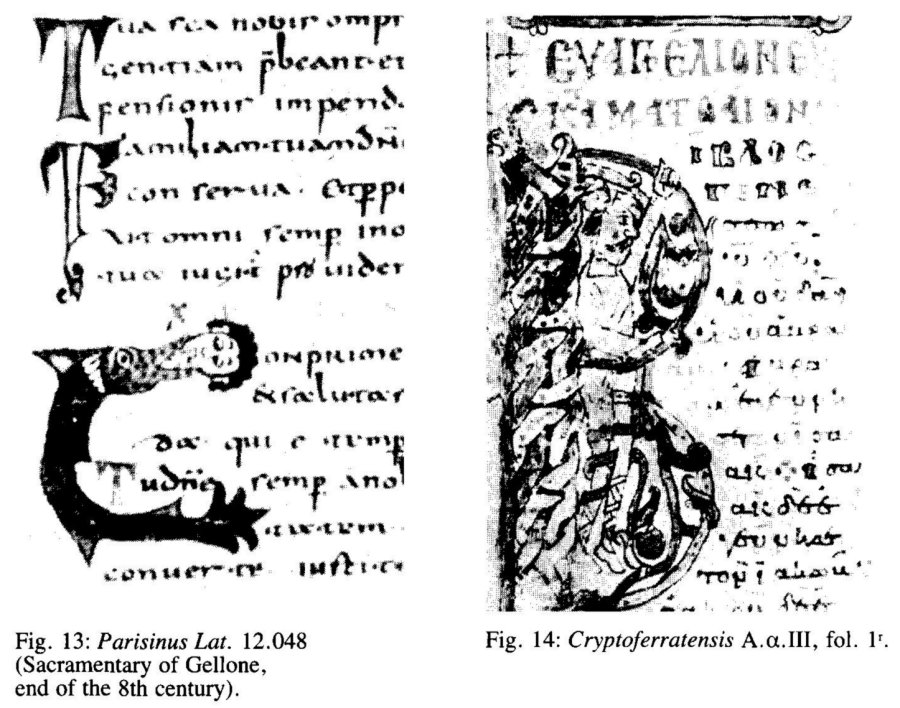
Fig. 13: Parisinus Lat. 12.048 (Sacramentary of
Gellone, end of the 8th century).
Fig. 14: Cryptoferratensis A.α.Ill, fol. 1r.
.
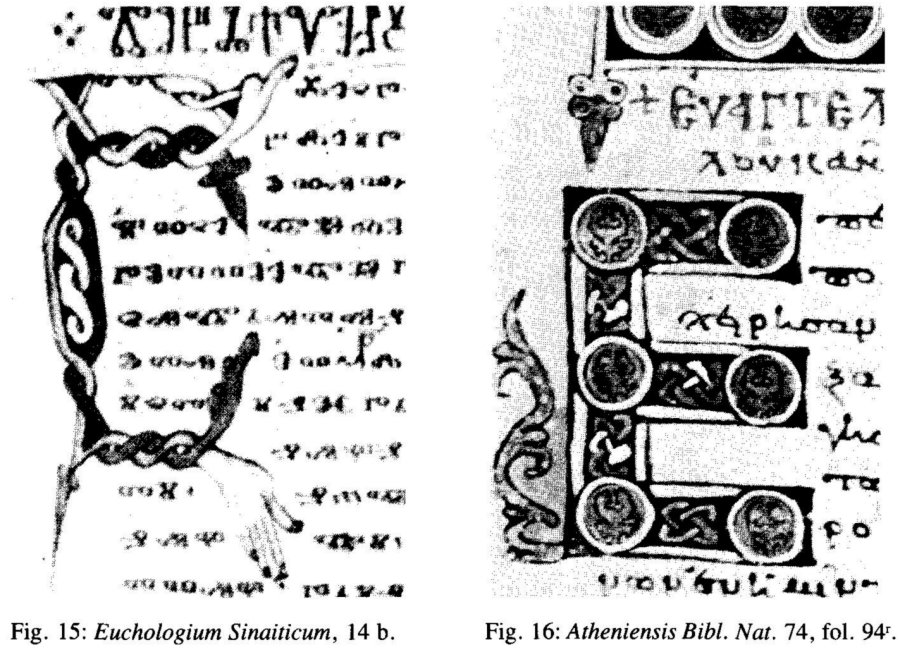
Fig. 15: Euchologium Sinaiticum, 14 b.
Fig. 16: Atheniensis Bibl. Nat. 74, fol. 94r.

129
.
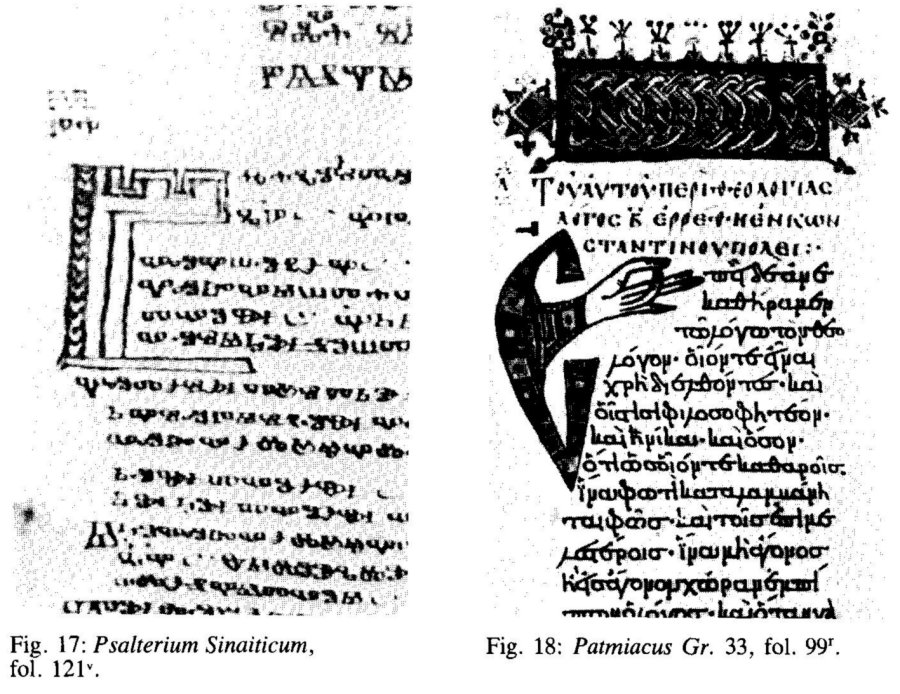
Fig. 17: Psalterium Sinaiticum, fol. 121v.
Fig. 18: Patmiacus Gr. 33, fol. 99r.
.
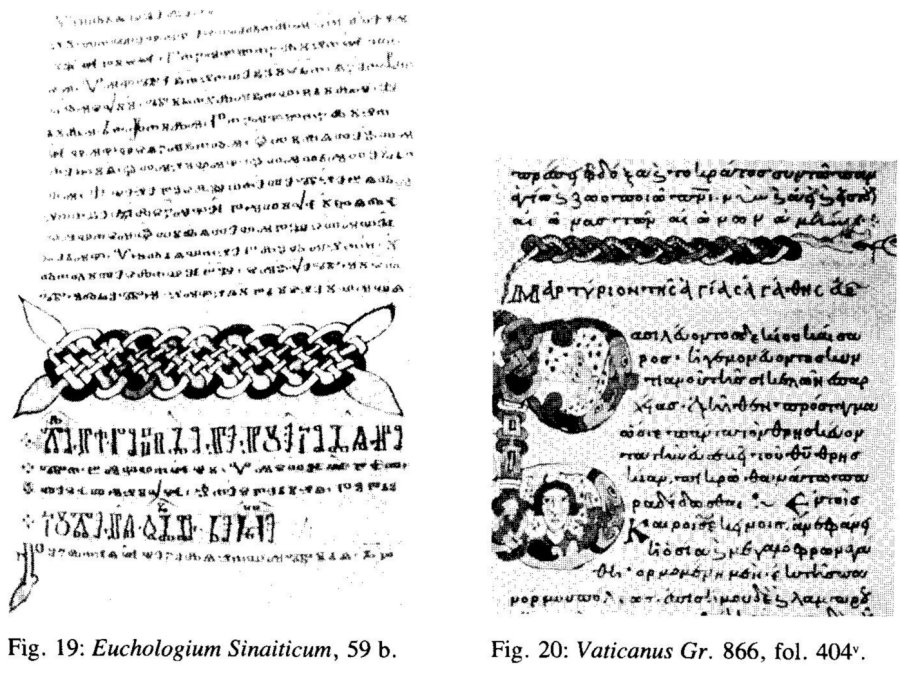
Fig. 19: Euchologium Sinaiticum, 59 b.
Fig. 20: Vaticanus Gr. 866, fol. 404v.

130
.
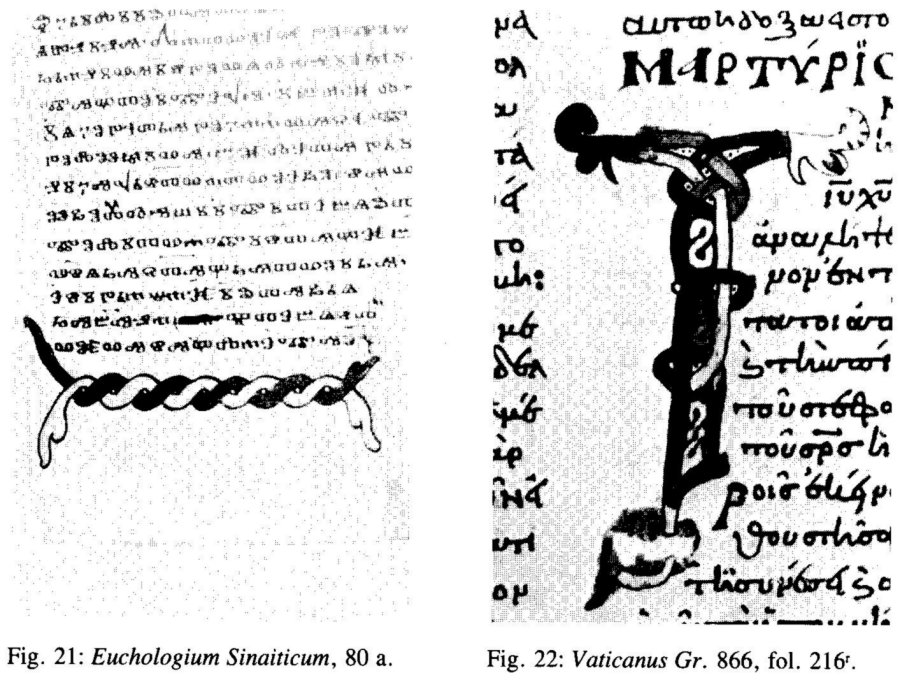
Fig. 21: Euchologium Sinaiticum, 80 a.
Fig. 22: Vaticanus Gr. 866, fol. 216r.
.

Fig. 23: Euchologium Sinaiticum, 32 b.
Fig. 24: Vaticanus Gr. 2138, fol. 29v (a.
991).

131
.
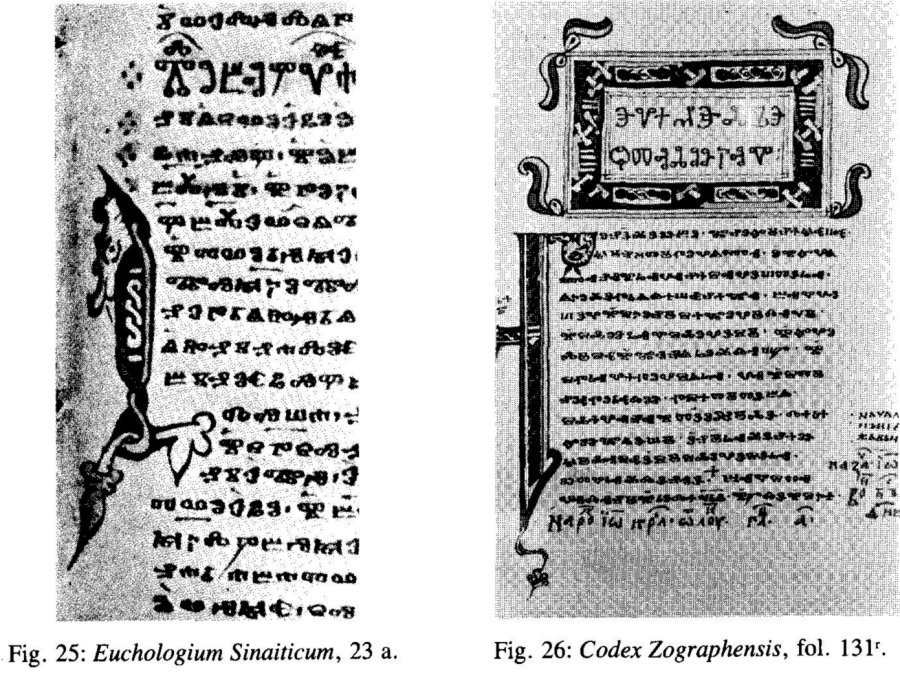
Fig. 25: Euchologium Sinaiticum, 23 a.
Fig. 26: Codex Zographensis, fol. 131r.
.
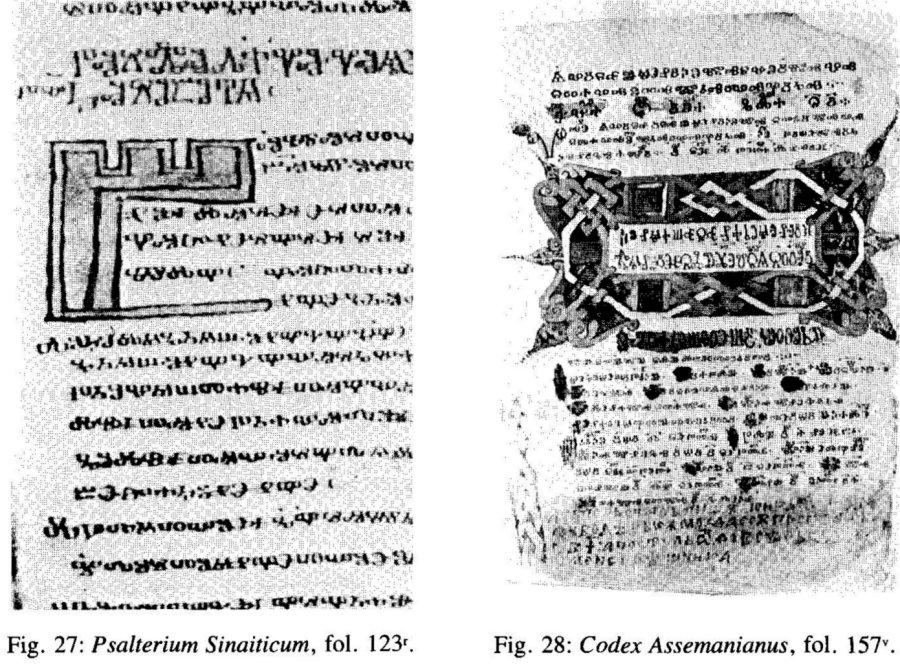
Fig. 27: Psalterium Sinaiticum, fol. 123r.
Fig. 28: Codex Assemanianus, fol. 157v.
